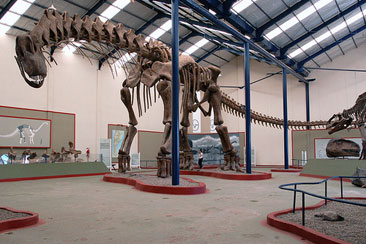Two hundred years of the birth of Charles Darwin See map
Charles Darwin was an English naturalist who devoted many years of his life to research. He spent several years traveling that helped him to formulate theories and discoveries. Patagonia was one of those places he traveled and in which he discovered species and corners unseen by his eyes.
200 years ago (1799) this scientist was born, who was a before and after in scientific thought to spread the theory of evolution of species.
 Fossil collecting gave Darwin data to formulate his theory. In the photo the Huinculensis Argentinosaurus at Plaza Huincul Musuem.
Fossil collecting gave Darwin data to formulate his theory. In the photo the Huinculensis Argentinosaurus at Plaza Huincul Musuem.In 1831, 27 December, along with Captain Fitz Roy on the Beagle ship they set sail on an expedition that would last five years. At first the objectives of the trip were raised in relation to geology and mapping. They compilled copies and mapped the South American coast. After, Darwin would know species, collect fossils, observe animals, such as the ostrich which he observed two kinds of ostriches that have territories separate but overlapping. All these findings begin to provide data to Darwin to support his theory of evolution.
Theory
The theory of evolution of species suggests that all species of life have evolved over time from a common ancestor through a process called natural selection. Thus, new species evolve or emerge from earlier species.
Darwin proposed that environmental and genetic differences in these organisms cause changes in them and that are better adapted to their environment over millions of years.
The most used is the explanation that the man shares his genetic material with chimpanzees, an animal that has evolved over thousands of years to become what we are today.
These revolutionary ideas were criticized at the time and still today, fo the church and those who have the vision of a world in which creation was from a divine law.
Darwin died in 1882 at age 73 and was buried in London, alongside other revolutionary scientific because of his discoveries, Isaac Newton.
After his death, it have been published manuscripts of Charles Darwin such as "The Origin of Species", published 17 years later, or "Journey of a Naturalist round the world" in which you can read about the places he visited on his journey through the world.
His work was reinterpreted and his theory used to other areas of life, for better or for worse. So much so, that the theory of evolution of species was used to justify social and racial differences, where from the famous phrase "the adaptation of the fittest" justified acts of slavery or racism among men. Although Darwin had said it was "absurd to speak of an animal is greater than another".
On February 12, 2009 it were completed 200 years after his birth.
Viajes por la Patagonia
Related Articles
© Patagonia.com.ar 2024 | Todos los derechos reservados.
